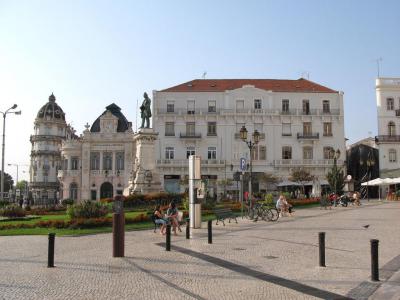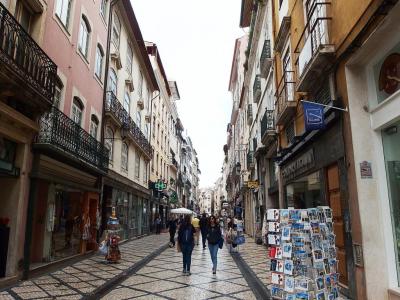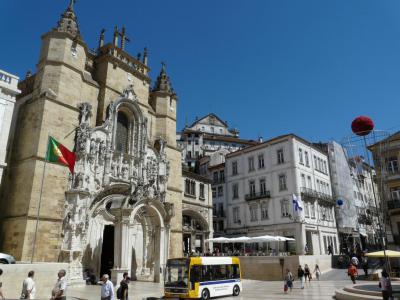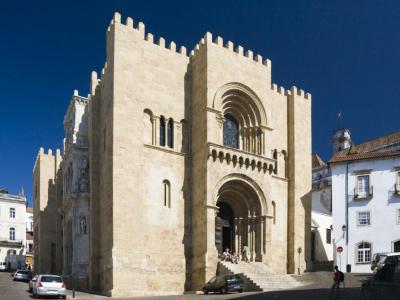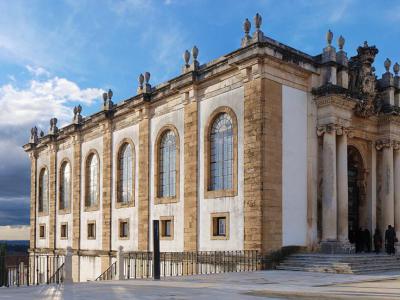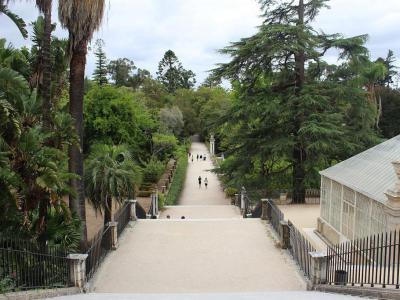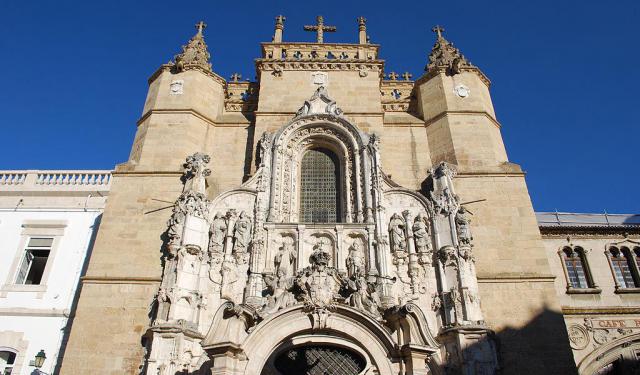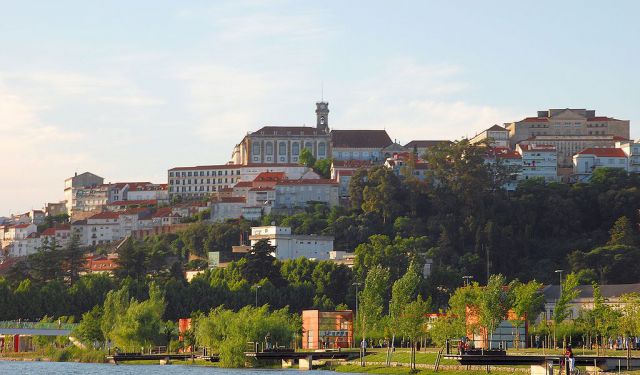
Coimbra Introduction Walking Tour (Self Guided), Coimbra
The ancient Roman city of Aeminium, by the Mondego River, eventually became the city of Coimbra. The modern Machado de Castro National Museum rests on the remains of a medieval bishop's palace. The palace was supported by an old cryptoporticus and Roman forum. The forum was the seed of the political and religious center of a city always reborn.
For more than 100 years Aeminium was held by Moorish conquerors. In the 9th century it was recaptured by Alfonso III of Asturias and Leon. The See and episcopal seat of Conimbriga was transferred to the city of Aeminium and Aeminium became Coimbra. Coimbra changed hands several times until in 1064, when it was taken by Ferdinand I of Castile.
Six Kings of Portugal were born in Coimbra. There was Sancho I and Sancho II, Afonso II and Afonso III, Pedro I and Ferdinand I. Portugal's oldest university, founded in Lisbon in 1290, was ultimately moved to Coimbra in 1537 as the University of Coimbra. It has a library holding 250,000 volumes and manuscripts.
Among the many old landmarks of the city are the 12th century Romanesque Old Cathedral; The Church of Sao Salvador; the New Cathedral of 1598; and the University of Coimbra and the Joanina Library.
Coimbra is a centuries-old monument-rich environment. It holds every phase and chapter of the story of architecture: Romanesque; Gothic; Mannerist; Renaissance; Baroque and all their neo derivatives.
Climb through the gate of Almedina to the uphill slope of Breakback Street to the "Alta" high above. Cross the University courtyard and climb the Clock Tower at sunset. From the top of the tower see all the city in every direction.
A good time of year in Coimbra is Spring. In May the graduating University students hold their "Burning of the Ribbons" festivities. Fado singers in black robes stroll about the streets after dark singing soulful songs of love and parting. The times are equally festive in summer. In the fall the students return, the cafes are busy and the city looks forward to winter.
For more than 100 years Aeminium was held by Moorish conquerors. In the 9th century it was recaptured by Alfonso III of Asturias and Leon. The See and episcopal seat of Conimbriga was transferred to the city of Aeminium and Aeminium became Coimbra. Coimbra changed hands several times until in 1064, when it was taken by Ferdinand I of Castile.
Six Kings of Portugal were born in Coimbra. There was Sancho I and Sancho II, Afonso II and Afonso III, Pedro I and Ferdinand I. Portugal's oldest university, founded in Lisbon in 1290, was ultimately moved to Coimbra in 1537 as the University of Coimbra. It has a library holding 250,000 volumes and manuscripts.
Among the many old landmarks of the city are the 12th century Romanesque Old Cathedral; The Church of Sao Salvador; the New Cathedral of 1598; and the University of Coimbra and the Joanina Library.
Coimbra is a centuries-old monument-rich environment. It holds every phase and chapter of the story of architecture: Romanesque; Gothic; Mannerist; Renaissance; Baroque and all their neo derivatives.
Climb through the gate of Almedina to the uphill slope of Breakback Street to the "Alta" high above. Cross the University courtyard and climb the Clock Tower at sunset. From the top of the tower see all the city in every direction.
A good time of year in Coimbra is Spring. In May the graduating University students hold their "Burning of the Ribbons" festivities. Fado singers in black robes stroll about the streets after dark singing soulful songs of love and parting. The times are equally festive in summer. In the fall the students return, the cafes are busy and the city looks forward to winter.
How it works: Download the app "GPSmyCity: Walks in 1K+ Cities" from Apple App Store or Google Play Store to your mobile phone or tablet. The app turns your mobile device into a personal tour guide and its built-in GPS navigation functions guide you from one tour stop to next. The app works offline, so no data plan is needed when traveling abroad.
Coimbra Introduction Walking Tour Map
Guide Name: Coimbra Introduction Walking Tour
Guide Location: Portugal » Coimbra (See other walking tours in Coimbra)
Guide Type: Self-guided Walking Tour (Sightseeing)
# of Attractions: 13
Tour Duration: 2 Hour(s)
Travel Distance: 2.2 Km or 1.4 Miles
Author: Caroline
Sight(s) Featured in This Guide:
Guide Location: Portugal » Coimbra (See other walking tours in Coimbra)
Guide Type: Self-guided Walking Tour (Sightseeing)
# of Attractions: 13
Tour Duration: 2 Hour(s)
Travel Distance: 2.2 Km or 1.4 Miles
Author: Caroline
Sight(s) Featured in This Guide:
- Largo da Portagem (Toll Square)
- Rua Ferreira Borges (Ferreira Borges Street)
- Arco de Almedina (Almedina Arch)
- Praça do Comercio (Commerce Square)
- Igreja de Santa Cruz (Santa Cruz Monastery)
- Fado ao Centro (Fado House)
- Rua de Quebra Costas (Backbreak Street)
- Sé Velha de Coimbra (Old Cathedral of Coimbra)
- Machado de Castro National Museum
- Sé Nova de Coimbra (New Cathedral of Coimbra)
- University of Coimbra Courtyard
- Biblioteca Joanina (Joanina Library)
- Jardin Botanique (Botanical Gardens)
1) Largo da Portagem (Toll Square)
Joaquim Antonio de Aguiar was the "Friar-Killer". As Minister of Justice after the Portuguese civil war in 1834, he stripped all religious orders of their properties and awarded the proceeds to the National Exchequer. For this he earned a statue by sculptor Costa Mota in the Toll Square of Coimbra, the Largo da Portagem.
Largo da Portagem can be translated as an open place to collect tolls. The square is of white marble and stone and landscaped with green areas and flower beds. Joaquim stands on a pedestal in the center of the square. The square borders the River Mondego and the Santa Clara Bridge. Toll collecting was a medieval practice.
Ornate baroque and modern buildings line the square. The two most remarkable edifices are The Bank of Portugal (not in the toll business) and the Astoria Hotel (1926). Both the bank and the hotel are the work of architect Adaes Bermudes, nephew of Costa Mota.
Caixa de Coimbra, Coimbra's Main Street and pedestrianized Ferreira Borges Street connect to the square. Ferreira Borges Street is home to a number of commercial stores. The square is a favorite venue for May festivities of students of Coimbra University.
When the weather is fine, cafes and patisseries in the neighborhood have chairs and tables on the street. The square is well lit at night.
Largo da Portagem can be translated as an open place to collect tolls. The square is of white marble and stone and landscaped with green areas and flower beds. Joaquim stands on a pedestal in the center of the square. The square borders the River Mondego and the Santa Clara Bridge. Toll collecting was a medieval practice.
Ornate baroque and modern buildings line the square. The two most remarkable edifices are The Bank of Portugal (not in the toll business) and the Astoria Hotel (1926). Both the bank and the hotel are the work of architect Adaes Bermudes, nephew of Costa Mota.
Caixa de Coimbra, Coimbra's Main Street and pedestrianized Ferreira Borges Street connect to the square. Ferreira Borges Street is home to a number of commercial stores. The square is a favorite venue for May festivities of students of Coimbra University.
When the weather is fine, cafes and patisseries in the neighborhood have chairs and tables on the street. The square is well lit at night.
2) Rua Ferreira Borges (Ferreira Borges Street)
Ferreira Borges Street is an aptly named shopping street. Jose Ferreira Borges (1786-1838), a graduate of Coimbra University, was an attorney and the leading author of the Portuguese Commercial Code of 1833, also called the Ferreira Borges Code. He wrote many books concerning economic and political topics.
Rua Ferreira Borges Street has had other names before Jose. It has followed the same path since the middle ages. It was the first street to be paved with cobble stones. It has always been a shopping street. It runs from the Church of Santa Cruz and the Town Hall to the river front and the Santa Clara Bridge.
The actual layout of the street has not undergone any widening or like changes in its existence. Because of this perhaps many mansions and buildings from the 17th and 18th centuries still line the way. Is there shopping? Yes, the best bookstores, patisseries, cafes, clothing stores and gift shops and offices of all kinds.
The street is mostly pedestrianized. It is a main passage of Caixa de Coimbra and it connects the Toll Square to Visconde da Luz Street. Jose would have loved it.
Rua Ferreira Borges Street has had other names before Jose. It has followed the same path since the middle ages. It was the first street to be paved with cobble stones. It has always been a shopping street. It runs from the Church of Santa Cruz and the Town Hall to the river front and the Santa Clara Bridge.
The actual layout of the street has not undergone any widening or like changes in its existence. Because of this perhaps many mansions and buildings from the 17th and 18th centuries still line the way. Is there shopping? Yes, the best bookstores, patisseries, cafes, clothing stores and gift shops and offices of all kinds.
The street is mostly pedestrianized. It is a main passage of Caixa de Coimbra and it connects the Toll Square to Visconde da Luz Street. Jose would have loved it.
3) Arco de Almedina (Almedina Arch)
In the 11th century the Arab conqueror Almansor rebuilt the walls around the conquered city of Coimbra. Only three gates permitted entrance to the citadel. Since that time almost all of the wall with exception of one gate have gone missing. The Almedina Arch, with its tower, Almadina Tower, form the only surviving medieval gate.
The arch is a vaulted arch and tunnel. "Almedina" is derived from the Arabic word for "town." The arched tunnels were defensive choke points designed to slow invaders. The tower over the Almedina Arch provided additional defensive functions. It was also a center for meetings of the municipal council.
A bell at the top of the tower would announce meetings of the council. The bell would also announce openings and closings of the city gates. The bell routine was followed faithfully until 1870. The tower once held a small chapel dedicated to Our Lady of the Conception. Mass was celebrated in the chapel before meetings of the Council.
In 1835 a better space was found for meetings and the tower was used off and on by other entities. Since 1988 it has been used to house Municipal Historical Archives. Passing through the arch one finds the Rua de Cuebra Costas (Backbreak Street). This aptly named street is a steep, exhausting climb to the old Cathedral of Coimbra.
The arch is a vaulted arch and tunnel. "Almedina" is derived from the Arabic word for "town." The arched tunnels were defensive choke points designed to slow invaders. The tower over the Almedina Arch provided additional defensive functions. It was also a center for meetings of the municipal council.
A bell at the top of the tower would announce meetings of the council. The bell would also announce openings and closings of the city gates. The bell routine was followed faithfully until 1870. The tower once held a small chapel dedicated to Our Lady of the Conception. Mass was celebrated in the chapel before meetings of the Council.
In 1835 a better space was found for meetings and the tower was used off and on by other entities. Since 1988 it has been used to house Municipal Historical Archives. Passing through the arch one finds the Rua de Cuebra Costas (Backbreak Street). This aptly named street is a steep, exhausting climb to the old Cathedral of Coimbra.
4) Praça do Comercio (Commerce Square)
What goes on in Commerce Square? That's a good question. The answer is, not so much in terms of commerce as there used to be. For centuries it was the Marketplace, the place where local people came to shop. These days it is a quiet place to take a break. Most of the shopping now takes place in the mall across the river.
The square is reached by climbing steps from pedestrianized Ferreira Borges Street. At each end of the square are the old churches of Sao Tiago and Sao Bartolomeu. Sao Bartolomeu is in the baroque style of the 18th century but the church itself goes back to the 10th century.
Saint Bart's faces the square. Facing Saint Bart's is a faithful reproduction of the "Pelourinho", the Pillory, from the 15th century. The pillory is two stone pillars. A common sight in Portuguese towns of yore, the pillars were signs of municipal power and used at times to chain criminals. An edifying sight as one leaves church of a Sunday.
Commerce Square, no longer a busy hive of commerce, is now called Praca Velha ("Old Square"). In the 16th century it was the location of the Royal Hospital. In 1790 most of the the hospital was moved to the Jesuit college by the new Cathedral. Not much is left in the Square.
The square today is a quiet place to relax at a table under one of the many umbrellas between the two churches. Rest, eat, drink and think about shopping.
The square is reached by climbing steps from pedestrianized Ferreira Borges Street. At each end of the square are the old churches of Sao Tiago and Sao Bartolomeu. Sao Bartolomeu is in the baroque style of the 18th century but the church itself goes back to the 10th century.
Saint Bart's faces the square. Facing Saint Bart's is a faithful reproduction of the "Pelourinho", the Pillory, from the 15th century. The pillory is two stone pillars. A common sight in Portuguese towns of yore, the pillars were signs of municipal power and used at times to chain criminals. An edifying sight as one leaves church of a Sunday.
Commerce Square, no longer a busy hive of commerce, is now called Praca Velha ("Old Square"). In the 16th century it was the location of the Royal Hospital. In 1790 most of the the hospital was moved to the Jesuit college by the new Cathedral. Not much is left in the Square.
The square today is a quiet place to relax at a table under one of the many umbrellas between the two churches. Rest, eat, drink and think about shopping.
5) Igreja de Santa Cruz (Santa Cruz Monastery) (must see)
Saint Theotonious, Portugal's first saint, was the driving inspiration for the Monastery and church of the Holy Cross. Santa Cruz Monastery was built between 1132 and 1223. The school and library of the Monastery were esteemed throughout the middle ages by intellectuals and political figures.
The early 16th century Romanesque monastery was completely redone by order of King Manuel. Diogo de Castilho, Machim and Jean of Rouen, Cristovao de Figureirado and Vasco Fernandes together with Chanterene, Boitaca and Diogo Pires the Younger all contributed art and labor to the rebirth of Santa Cruz Monastery.
The tombs of King Afonso Henriques and King Sancho I were transferred to the main chapel in 1530. Diogo de Boitaca created the plans for the church and the ribbed ceilings of the Chapter House. The Chapel of Saint Michael, the Cloister of Silence and the main portal complement and harmonize with the Manueline and Renaissance elements.
The carved choir stalls were installed in 1580. The stalls have a frieze of Portuguese ships in the Age of Discovery. The very complicated organ takes four people to play it. It has Japanese adornments and 4,000 pipes. Interior decorations feature Baroque azulejo tile panels.
The interior mixes Gothic and Baroque elements. A floridly sculpted arch in the facade opens to a cloister which is a perfect example of Manueline architecture.
The early 16th century Romanesque monastery was completely redone by order of King Manuel. Diogo de Castilho, Machim and Jean of Rouen, Cristovao de Figureirado and Vasco Fernandes together with Chanterene, Boitaca and Diogo Pires the Younger all contributed art and labor to the rebirth of Santa Cruz Monastery.
The tombs of King Afonso Henriques and King Sancho I were transferred to the main chapel in 1530. Diogo de Boitaca created the plans for the church and the ribbed ceilings of the Chapter House. The Chapel of Saint Michael, the Cloister of Silence and the main portal complement and harmonize with the Manueline and Renaissance elements.
The carved choir stalls were installed in 1580. The stalls have a frieze of Portuguese ships in the Age of Discovery. The very complicated organ takes four people to play it. It has Japanese adornments and 4,000 pipes. Interior decorations feature Baroque azulejo tile panels.
The interior mixes Gothic and Baroque elements. A floridly sculpted arch in the facade opens to a cloister which is a perfect example of Manueline architecture.
6) Fado ao Centro (Fado House) (must see)
Fado means "fate." It is also sad or soulful music and singing. There are two types of fado, that of Lisbon and that of Coimbra. Lisbon style is more well known, linked to working-class life and the poor. Coimbra style is traditionally that of medieval troubadours and linked to the city's university.
In Coimbra fado is traditionally sung by men wearing academic robes or capes. The singing is at night in the darkened squares and streets. The favorite venues are the steps of Santa Cruz Monastery and the Old Cathedral. It is also performed as a serenade beneath a lucky lady's window.
Every evening at six the Fado House has an hour long concert of fado. The venue is located on the Rua do Quebra Costas (Backbreak Street), up a little ways from the Almedina Arch. Besides the 6 pm performances, the Fado House opens daily at 10 am. It has a library of books, Cds and DVds. There are always musicians around to chat with.
Reservations are recommended for performances. No food is served but a glass of the local Port wine may be had for the concerts. Rehearsals are held between 4 pm and 5:30 pm.
In Coimbra fado is traditionally sung by men wearing academic robes or capes. The singing is at night in the darkened squares and streets. The favorite venues are the steps of Santa Cruz Monastery and the Old Cathedral. It is also performed as a serenade beneath a lucky lady's window.
Every evening at six the Fado House has an hour long concert of fado. The venue is located on the Rua do Quebra Costas (Backbreak Street), up a little ways from the Almedina Arch. Besides the 6 pm performances, the Fado House opens daily at 10 am. It has a library of books, Cds and DVds. There are always musicians around to chat with.
Reservations are recommended for performances. No food is served but a glass of the local Port wine may be had for the concerts. Rehearsals are held between 4 pm and 5:30 pm.
7) Rua de Quebra Costas (Backbreak Street)
Is it popular for the challenge of a climb? The only thing that is certain is that Breakback Street is indeed one of the most popular streets in Coimbra. It can be found in the historical center of the city. Take the Ferreira Borges Street to the Almedina Arch. Pass through the Arch to Quebra Costas Street.
It is a narrow whitewashed street that winds steeply upward. There are stairs, and more stairs. The street seems to narrow more and more as one ascends. At the top of the hill is the Old Cathedral of Coimbra and the University. Climbing to the top one may develop a thirst. Hooray, there are bars, gift shops and great views.
What goes up must come down. Descending, the wise walker will mind his/her footing. Altogether, the Backbreaker Street is a popular socializing spot for visitors and locals alike. All along the way there are options for coffee, Portuguese egg custard tart and tapas.
It is a narrow whitewashed street that winds steeply upward. There are stairs, and more stairs. The street seems to narrow more and more as one ascends. At the top of the hill is the Old Cathedral of Coimbra and the University. Climbing to the top one may develop a thirst. Hooray, there are bars, gift shops and great views.
What goes up must come down. Descending, the wise walker will mind his/her footing. Altogether, the Backbreaker Street is a popular socializing spot for visitors and locals alike. All along the way there are options for coffee, Portuguese egg custard tart and tapas.
8) Sé Velha de Coimbra (Old Cathedral of Coimbra) (must see)
Old Cathedral of Coimbra is the only Portugese Romanesque cathedral which has survived intact. Construction began after the Battle of Ourique in 1139. Prince Afonso Henriques had declared himself King of Portugal. He chose Coimbra to be his capital. Sancho I, second King of Portugal was crowned in the cathedral in 1185.
Building the cathedral was slow going. The basic structure was not finished until the early 13th century. The cloisters were not begun until 1218. The plans and construction of the cathedral are generally credited to a mysterious Master Robert, a French architect. The works were directly supervised by another mysterious Master Bernard.
The Old Cathedral has the look of a little fortress. It has high crenelated walls with almost no windows. A high tower in the west facade, showing Romanesque and Arabic elements, is reinforced by heavy buttresses at the corners. The north facade has a renaissance portal by sculptor Jean of Rouen.
The capitals of the Romanesque decorations feature stone carvings of birds and four-footed creatures and birds but no human figures. Most of the artisans that worked on the Old Cathedral were mozarabic. They were Christians who had lived and worked in Arab lands. They were not used to human representations, which were banned under Islam.
Building the cathedral was slow going. The basic structure was not finished until the early 13th century. The cloisters were not begun until 1218. The plans and construction of the cathedral are generally credited to a mysterious Master Robert, a French architect. The works were directly supervised by another mysterious Master Bernard.
The Old Cathedral has the look of a little fortress. It has high crenelated walls with almost no windows. A high tower in the west facade, showing Romanesque and Arabic elements, is reinforced by heavy buttresses at the corners. The north facade has a renaissance portal by sculptor Jean of Rouen.
The capitals of the Romanesque decorations feature stone carvings of birds and four-footed creatures and birds but no human figures. Most of the artisans that worked on the Old Cathedral were mozarabic. They were Christians who had lived and worked in Arab lands. They were not used to human representations, which were banned under Islam.
9) Machado de Castro National Museum (must see)
When Coimbra was Aeminium it was a city of the Roman empire. Like other cities, it had a forum. The Aeminium forum was supported by a cryptoporticus, a semi-underground gallery with vaulted ceilings and arches to support above ground structures. Most of Aeminium is gone, replaced by Coimbra. The forum and the cryptoporticus remain.
Supported by the cryptoporticus, the forum, in turn, supports the Bishop's Palace. The Bishop's palace dates from the middle ages. Today it is the home of the Machado de Castro National Museum. Joaquim Machado de Castro (1731-1822) was one of Portugal's greatest sculptors. He presided over his own school and he was Master to many artists.
The museum opened in 1913. The majority of the museum's permanent collection consists of items of a religious nature from areas surrounding Coimbra.
The museum has the most extensive collection of sculptures among Portuguese museums. The exhibits of paintings, ceramics, precious metals and textiles are especially fine.
The museum occupies three floors above the old forum. It has a pleasant cafe with a terrace for outdoor seating. The terrace overlooks terrific views of the city. The time spent in the museum is never enough.
Supported by the cryptoporticus, the forum, in turn, supports the Bishop's Palace. The Bishop's palace dates from the middle ages. Today it is the home of the Machado de Castro National Museum. Joaquim Machado de Castro (1731-1822) was one of Portugal's greatest sculptors. He presided over his own school and he was Master to many artists.
The museum opened in 1913. The majority of the museum's permanent collection consists of items of a religious nature from areas surrounding Coimbra.
The museum has the most extensive collection of sculptures among Portuguese museums. The exhibits of paintings, ceramics, precious metals and textiles are especially fine.
The museum occupies three floors above the old forum. It has a pleasant cafe with a terrace for outdoor seating. The terrace overlooks terrific views of the city. The time spent in the museum is never enough.
10) Sé Nova de Coimbra (New Cathedral of Coimbra)
In 1772 the episcopal seat was moved from the Old Cathedral of Coimbra to the empty, roomier and and more modern New Cathedral of Coimbra. Built in 1541 and completed in the 17th century, the New Cathedral had been the Jesuit Headquarter of Coimbra. But in 1759 the Jesuits had been evicted from Portugal by the 1st Marquis of Pombal.
Pombal was Chief Minister of King Joseph I. He had banned the Jesuits for their possible involvement in the attempted assassination of the King. He was a liberal reformer who effectively ruled Portugal during the reign of Joseph I.
The basic style of the cathedral is Baroque in the upper part of the facade and Mannerist in the lower part. Niches of the facade hold statues of four Jesuit saints. They were the only Jesuits not evicted by Pombal. There are two bell towers immediately behind the facade and a dome atop the transept.
The inside of the cathedral has barrel vaults, a nave with chapels and a dome and cupola. There are enormous gilded wood altarpieces from the 17th century in the arms of the transept and the main chapel. The side chapel altarpieces are Mannerist and Baroque.
Choir stalls in the main chapel and the carved baptismal font were taken from the Old Cathedral. The carvings were made in the 16th century Gothic-Manueline style by Pero and Felipe Henriques.
Pombal was Chief Minister of King Joseph I. He had banned the Jesuits for their possible involvement in the attempted assassination of the King. He was a liberal reformer who effectively ruled Portugal during the reign of Joseph I.
The basic style of the cathedral is Baroque in the upper part of the facade and Mannerist in the lower part. Niches of the facade hold statues of four Jesuit saints. They were the only Jesuits not evicted by Pombal. There are two bell towers immediately behind the facade and a dome atop the transept.
The inside of the cathedral has barrel vaults, a nave with chapels and a dome and cupola. There are enormous gilded wood altarpieces from the 17th century in the arms of the transept and the main chapel. The side chapel altarpieces are Mannerist and Baroque.
Choir stalls in the main chapel and the carved baptismal font were taken from the Old Cathedral. The carvings were made in the 16th century Gothic-Manueline style by Pero and Felipe Henriques.
11) University of Coimbra Courtyard (must see)
Coimbra University was founded in 1290 by King Dinis. The university moved fitfully between Lisbon and Coimbra until 1537. Then, in the reign of John III, it moved permanently to Coimbra. It was housed in the Alcacova Palace. The palace was subsequently purchased from the Royal Family in 1597.
The library was a gift of King John V. King John could afford it. Gold from Brazil made him the richest king in the world. The library holds 200,000 or more books. In the library are tiny bats that feed on bookworms at night. Bat guano is swept up in the morning by library staff.
The University's crenelated clock tower is 112 feet high. It was formerly used for astronomical observations. It is roofless. Visitors are permitted at the top to get a great view of the city. The clock tower has two bells. One, called "the Goat", rings at 6 pm. The second, called "the Bitch" rings at 7:30 am, waking students for class.
Access to the University courtyard is through the Porta Ferrea ("Iron Gate"), the old gate to the palace. Before entering, one will encounter a stone pavement portrait of the goddess Minerva. She is the goddess of wisdom, medicine, commerce, artisanship, poetry and art. She looks serene, guarding piles of books. She doesn't need bats.
The courtyard, known as Courtyard of Schools, is a vast open area surrounded by buildings of the old campus. There is a statue of King John III. His back is turned to the city. He faces the university. The statues in the courtyard include King Dinis I and Denosthenes offering some words, silently.
Not all parts of the University are open to the public. No more than 60 people are allowed to visit at a time.
Why You Should Visit:
The square offers great views of the city below and access to the original historic buildings, such as the Joanina Library, the Royal Palace, the Chapel and the great Bell Tower.
Tips:
Some fees may be charged to visit the buildings. Make tour reservations early. If you climb the tower wear strong shoes.
The library was a gift of King John V. King John could afford it. Gold from Brazil made him the richest king in the world. The library holds 200,000 or more books. In the library are tiny bats that feed on bookworms at night. Bat guano is swept up in the morning by library staff.
The University's crenelated clock tower is 112 feet high. It was formerly used for astronomical observations. It is roofless. Visitors are permitted at the top to get a great view of the city. The clock tower has two bells. One, called "the Goat", rings at 6 pm. The second, called "the Bitch" rings at 7:30 am, waking students for class.
Access to the University courtyard is through the Porta Ferrea ("Iron Gate"), the old gate to the palace. Before entering, one will encounter a stone pavement portrait of the goddess Minerva. She is the goddess of wisdom, medicine, commerce, artisanship, poetry and art. She looks serene, guarding piles of books. She doesn't need bats.
The courtyard, known as Courtyard of Schools, is a vast open area surrounded by buildings of the old campus. There is a statue of King John III. His back is turned to the city. He faces the university. The statues in the courtyard include King Dinis I and Denosthenes offering some words, silently.
Not all parts of the University are open to the public. No more than 60 people are allowed to visit at a time.
Why You Should Visit:
The square offers great views of the city below and access to the original historic buildings, such as the Joanina Library, the Royal Palace, the Chapel and the great Bell Tower.
Tips:
Some fees may be charged to visit the buildings. Make tour reservations early. If you climb the tower wear strong shoes.
12) Biblioteca Joanina (Joanina Library) (must see)
The Biblioteca Joanina is named for King John V, The king who loved books. He also loved libraries and he built them. Construction started in 1717 at the insistence of King John and the building was finished in 1728. The library collection was moved constantly before this, the collection growing and no place fit to hold it.
The reknowned architect Gaspar Ferreira is responsible for the design. The library consists of three sizable rooms lined with bookstands. Narrow corridors in the rooms carry the coats of arms of the various faculties of the University. Renovated several times, it is a Baroque creation of teams of artists working together.
The library collection has grown so much books published in the 20th century onwards are held in the Faculty of Letters building. The building was adapted as a library by Architect Albero Jose Pessoa, assisted by Horacio de Moura and Fernando Castelo Branco. The books dating from the 12th to 19th centuries remain in the Joanina Library.
The Biblioteca Joanina is the main attraction for library-loving visitors to the old campus. The interior is lavishly Baroque in style, sumptuously adorned in red and gold embellishments of arches and carvings. Painted panels on the ceilings are by Antonio Simoes Ribeiro and Vincente Nunes. Chinese elements are painted by Manuel De Silva.
Under the main floor is the "Prison" room. In days of yore offending Scholars and students were confined here. Respect for learning and study was taken seriously.
Books have enemies: humidity and insects. The Joanina library deals with these enemies in two ways. The effects of humidity are minimized by the use of hardwoods like teak and oak. These woods are not that tasty for bugs either. For those bugs and bookworms that get past the teak and the oak there are bats. Tiny bats that feed at night.
Why You Should Visit:
Don't worry about the bats. To spend some time in this beautiful place surrounded by the wisdom of the ages is a rare treat not available to everyone.
Tips:
Tours may be crowded. Come early.
The reknowned architect Gaspar Ferreira is responsible for the design. The library consists of three sizable rooms lined with bookstands. Narrow corridors in the rooms carry the coats of arms of the various faculties of the University. Renovated several times, it is a Baroque creation of teams of artists working together.
The library collection has grown so much books published in the 20th century onwards are held in the Faculty of Letters building. The building was adapted as a library by Architect Albero Jose Pessoa, assisted by Horacio de Moura and Fernando Castelo Branco. The books dating from the 12th to 19th centuries remain in the Joanina Library.
The Biblioteca Joanina is the main attraction for library-loving visitors to the old campus. The interior is lavishly Baroque in style, sumptuously adorned in red and gold embellishments of arches and carvings. Painted panels on the ceilings are by Antonio Simoes Ribeiro and Vincente Nunes. Chinese elements are painted by Manuel De Silva.
Under the main floor is the "Prison" room. In days of yore offending Scholars and students were confined here. Respect for learning and study was taken seriously.
Books have enemies: humidity and insects. The Joanina library deals with these enemies in two ways. The effects of humidity are minimized by the use of hardwoods like teak and oak. These woods are not that tasty for bugs either. For those bugs and bookworms that get past the teak and the oak there are bats. Tiny bats that feed at night.
Why You Should Visit:
Don't worry about the bats. To spend some time in this beautiful place surrounded by the wisdom of the ages is a rare treat not available to everyone.
Tips:
Tours may be crowded. Come early.
13) Jardin Botanique (Botanical Gardens) (must see)
In his career as King's Minister, the Marques de Pombal had to juggle a lot of new projects. One he must have loved was to be the energizing spirit behind the creation of the Botanical Garden of Coimbra. The project was meant to complement nature studies and medicine at the University of Coimbra.
The garden is not small. It covers 32 acres divided into two parts. The first part, located in the highest part of the valley, is the more formal part, laid out in terraces. The lower terrace, The Central Square, is a European garden of the 18th century.
The next terrace is the Order Beds. Plants are cultivated for botany students and for exchange with other gardening institutions. Next come the Greenhouses. Tropical and subtropical plants are carefully tended according to their special needs of humidity and warmth.
The second part of the Botanical Gardens includes a former creek bed with an arboretum. The arboretum features a bamboo forest, shrubbery and rare trees including 51 types of eucalyptus. Fauna also live in the garden. Birds are sheltered in their natural surroundings. There are squirrels as well.
There are monumental statues in the garden. Dating from 1859, one of the oldest iron architecture buildings in Portugal is used for tropical plants including over twenty species of flesh-eating plants. Guided group tours must be booked in advance. No smoking and no flower picking, thanks.
The garden is not small. It covers 32 acres divided into two parts. The first part, located in the highest part of the valley, is the more formal part, laid out in terraces. The lower terrace, The Central Square, is a European garden of the 18th century.
The next terrace is the Order Beds. Plants are cultivated for botany students and for exchange with other gardening institutions. Next come the Greenhouses. Tropical and subtropical plants are carefully tended according to their special needs of humidity and warmth.
The second part of the Botanical Gardens includes a former creek bed with an arboretum. The arboretum features a bamboo forest, shrubbery and rare trees including 51 types of eucalyptus. Fauna also live in the garden. Birds are sheltered in their natural surroundings. There are squirrels as well.
There are monumental statues in the garden. Dating from 1859, one of the oldest iron architecture buildings in Portugal is used for tropical plants including over twenty species of flesh-eating plants. Guided group tours must be booked in advance. No smoking and no flower picking, thanks.
Walking Tours in Coimbra, Portugal
Create Your Own Walk in Coimbra
Creating your own self-guided walk in Coimbra is easy and fun. Choose the city attractions that you want to see and a walk route map will be created just for you. You can even set your hotel as the start point of the walk.
Historic Buildings Walking Tour
Amid the array of historic buildings narrating the cultural and architectural heritage of Coimbra, Portugal, there are both secular structures and great churches, dating back centuries. Apart from their historical value, these buildings exemplify the resplendent European architecture of the past, featuring Baroque, Renaissance, Rococo, and other styles. Some of them are richly decorated on the... view more
Tour Duration: 1 Hour(s)
Travel Distance: 1.8 Km or 1.1 Miles
Tour Duration: 1 Hour(s)
Travel Distance: 1.8 Km or 1.1 Miles
The Most Popular Cities
/ view all
